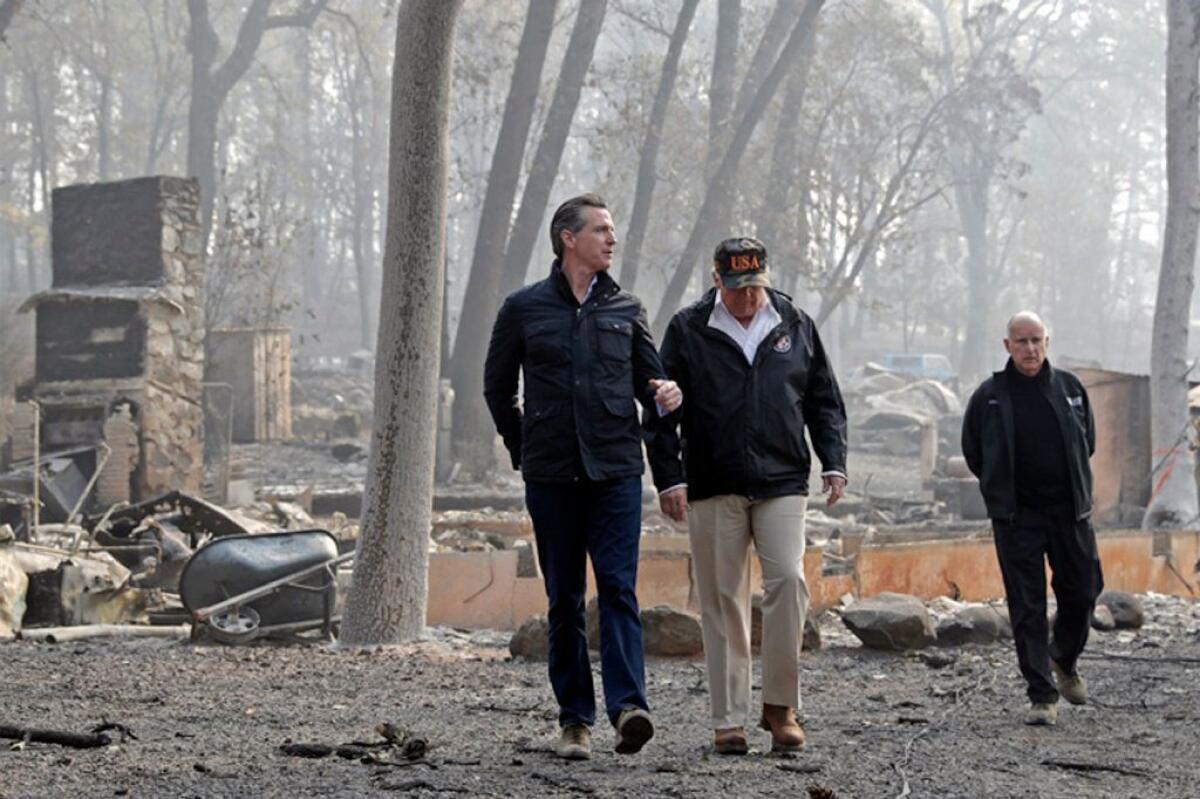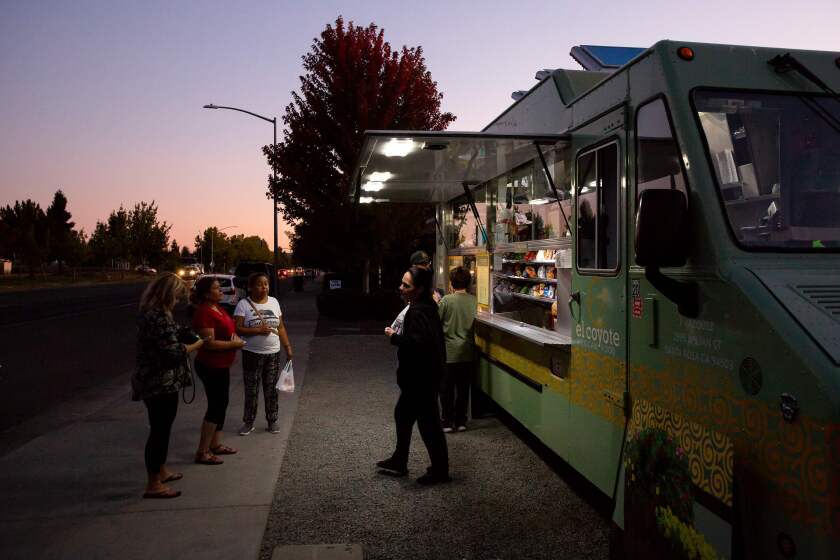For Gov. Newsom, PG&E power outages offer political rewards — and some big risks

- Share via
SACRAMENTO — Gov. Gavin Newsom stood in the nerve center of the state’s emergency operations center Thursday and delivered a blistering critique of Pacific Gas & Electric Co.’s decision to blanket Central and Northern California with blackouts, affecting hundreds of thousands of residents.
As screens behind him displayed television news footage of a building in flames, maps of outages and weather conditions across the state, Newsom said, “This can’t be the new normal.”
“What has occurred in the last 48 hours is unacceptable,” Newsom said, standing before the news cameras. “You’ve got people that can’t even access water, or medical supplies. We’re seeing a scale and scope of something that no state in the 21st century should experience.”
But Newsom’s well-staged excoriation of one of the nation’s largest utilities, now wallowing in bankruptcy, came more than 36 hours after the blackouts began and struck a different tone than the message he delivered just a day earlier. As public anger swelled in PG&E territory and in a state with a history of blaming its leader in a power crisis, Newsom’s political vulnerability became more clear and the Democratic governor changed course.
“I think the public reaction to this for a lot of people, including some who still don’t have power, was angry and frustrated and pretty vocal,” said Joseph Tuman, professor of political and legal communication at San Francisco State. “Even if you’re the governor and you’re trying to do the right thing, people want to take it out on someone. Angry people today can make angry voters in the next election cycle.”
Tuman called Newsom’s news conference a day late, “but better late than never.”
The morning after the lights in Northern California began to be shut off, Newsom was on the opposite end of the state holding news conferences trumpeting housing legislation and other bills that he was signing into law.
In San Diego, he said the outages were the result of PG&E neglecting its infrastructure and talked about how his own wine businesses were suffering in the midst of harvest season. Hours later in Crenshaw, Newsom said the situation was better than the alternative of deadly wildfires and that the state will continue to face greater threats from wildfires due to climate change.
“Everybody is prepared,” Newsom said. “Those winds are coming down here. Over the course of the next few days will be determinative in terms of our ability to get out of this. This is the new normal.”
At the same time, Newsom was taking heat for tweeting about capping rent and cracking down on robocalls while schoolchildren sat in dark classrooms and food spoiled in warm refrigerators. Some Twitter users were quick to remind Newsom that the state recalled one of his predecessors over blackouts.
Instead, Newsom should have put on a windbreaker and toured areas of California hardest hit by the blackouts, said Steven Maviglio, a veteran Democratic strategist in Sacramento.
“There were millions of dollars in economic losses, people being moved out of nursing homes. This is a real crisis for a lot of people. It needs to be treated that way,” Maviglio said.
Maviglio went through this almost two decades ago as the press secretary for Democratic Gov. Gray Davis.
Davis’ slow response to the 2000-2001 energy crisis in California, which triggered rolling blackouts across the state and near financial ruin for utilities, inflicted a political wound that never healed. Voter outrage led in large part to Davis’ recall in 2003 and the election of Gov. Arnold Schwarzenegger.
The crisis was triggered by the illegal market manipulation of Enron Corp. and other energy companies that took advantage of California’s decision, before Davis took office, to deregulate the utility industry.
To the outside world, California and Davis appeared too politically paralyzed and inept to manage and deliver an essential, basic service for millions of residents. Only later did evidence surface of wrongdoing by Enron and others.
Many agree that Newsom’s current challenge bears little resemblance to the state’s 2000-2001 energy debacle, but similar political perils remain.
“At the end of the day, Californians believe that when you flip the switch, the lights should come on,” Maviglio said. “They look to leaders to fix things.”
Newsom on Thursday laid out his administration’s efforts to address wildfires and power outages, which include $75 million in one-time budget funds to help communities prepare for shut-offs. But so far, none of that money has been awarded, according to the state Office of Emergency Services.
The governor also took PG&E to task for cutting power too broadly and in areas of the state that weren’t at risk. Newsom pledged to “hold PG&E’s feet to the fire” and ensure the company was meeting its safety requirements and obligations to cut back its trees around power lines.
More than a million Californians remained without power Thursday after PG&E shut off electricity in an attempt to prevent devastating wildfires.
But in the short term, Newsom can’t do much more than coordinate the state’s response over the next few months.
Unlike San Diego Gas & Electric Co., PG&E doesn’t have the technology to localize its shut-offs and limit the outages to areas facing serious wildfire threats, which is why some urban areas outside fire zones lost power this week.
State laws and regulations also give utilities the power to flip the lights off as they see fit to protect public safety. Though the California Public Utilities Commission requires the utilities to set thresholds for weather conditions to cut electricity, the utilities can ultimately exercise their own discretion. Several new state laws that tighten the rules around shut-offs and warnings take effect next year, but they leave utilities with the decision-making power.
Sen. Scott Wiener (D-San Francisco) said the setup gives utilities sole discretion to make decisions that affect thousands of small businesses throughout the state, some of which can’t close for a few days without suffering detrimental losses.
“We have a bankrupt corporation owned by hedge funds deciding whether the Northern California economy can function,” Wiener said. “The Legislature and the governor have done a lot the last two years to try to address this horrific wildfire situation and a lot of good changes have been made, but the next step is going to be around how to deal with these blackouts.”
Newsom was asked Thursday whether California’s laws should be changed to give the state more control over outages.
“Then you own it and you own the decision not to do something,” Newsom said, suggesting the state would be responsible for the outcome.
The governor went on to point out that SDG&E, a smaller utility with more advanced technology, has done a much better job of managing its electrical system than PG&E and without the intervention of government.
One distinct advantage that Newsom has is a glaringly obvious “boogeyman” to blame for the blackouts: PG&E, said Garry South, who worked as a top political advisor to both Davis and Newsom.
The utility not only was responsible for California’s deadliest and most destructive wildfire, the 2018 blaze that destroyed the Northern California town of Paradise, but also was found criminally negligent for the natural gas pipeline explosion in 2010 that killed eight people in a San Bruno residential neighborhood.
“In Newsom’s case, he has the advantage of being able to say that this is not the state’s fault, this is not the [federal] government’s fault, this is not the customers’ fault. This is PG&E’s fault,” South said.
The underpinnings of the 2000-2001 energy crisis were too complex to easily explain to Californians, and the underhanded actions of Enron were not revealed until after the crisis subsided, South said.
For Davis, the political consequences were swift. After years of high marks in statewide opinion polls, California voters soured on Davis in just a few months, said Mark DiCamillo, director of polling at the UC Berkeley Institute of Governmental Studies.
By May 2001, 55% of voters disapproved of Davis’ job as governor, according to a Field Poll. At the time, DiCamillo worked for that separate polling operation.
“It turned very quickly,” DiCamillo said. “Then things got messier beyond the energy crisis.”
What followed was a California economy flattened by the dot-com bust and Davis’ subsequent decision to rescind a law that lowered vehicle license fees, dubbed the “car tax,” which only added more fuel to the recall effort against him.
Newsom has yet to face anything like that confluence of political misfortune, but even he has warned that California’s economy could face a stormy future.
If the economy tanks and widespread blackouts continue, Newsom could see his approval ratings and political prospects spiral downward.
Davis, from his vantage point, is confident Newsom will be fine.
“His situation is considerably different. First of all, he is totally on top of this problem. He was working on wildfires during his campaign,” Davis said in a telephone interview. “By this time next year, we should be in a better position than we are now.”
More to Read
Sign up for Essential California
The most important California stories and recommendations in your inbox every morning.
You may occasionally receive promotional content from the Los Angeles Times.













